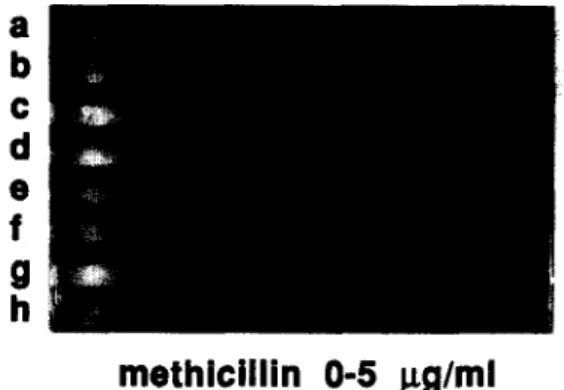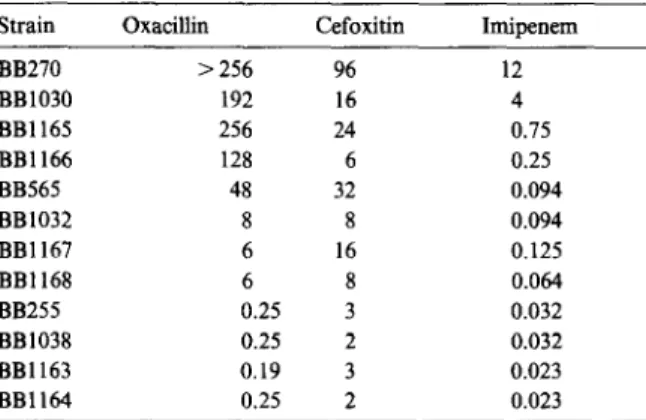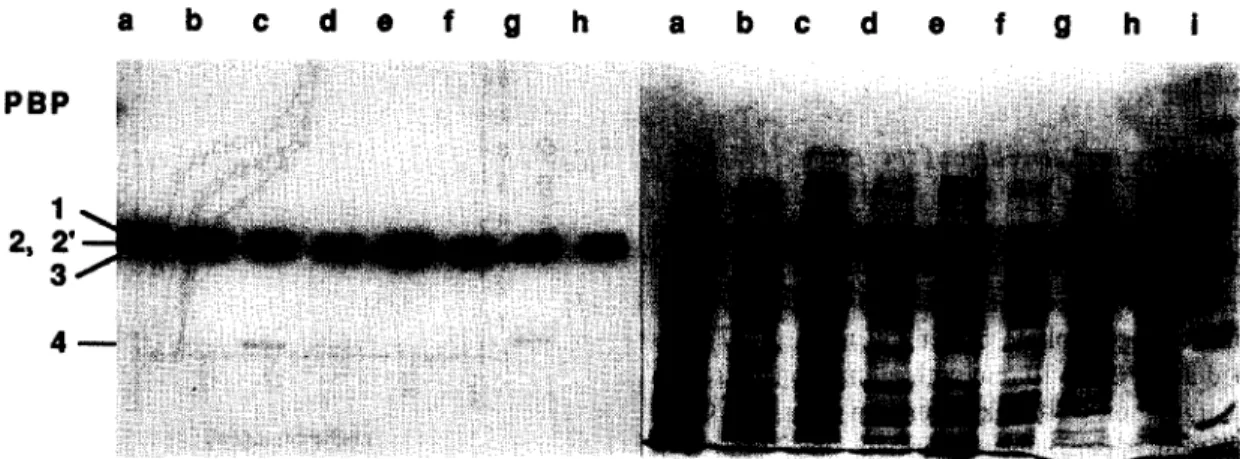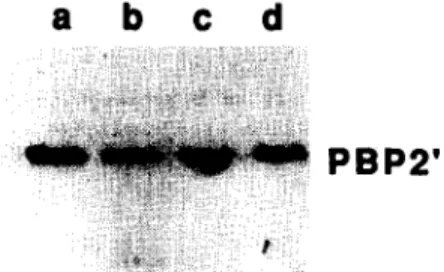ELSEVIER
FEMS Microbiology Letters 141 (1996) 255-260Impact of
sar
and
agr
on methicillin resistance in
Staphylococcus aureus
S. Piriz Durb
‘, F.H. Kayser b, B. Berger-B&hi bt*
a Department of Medicine and Animal Health, Faculty of Veterinary Medicine, University of Extremadura, 10 071 Criceres, Spain b Institute of Medical Microbiology. University of Ziirich, Postfach, CH-8028 Ziirich, Switzerland
Received 15 May 1996; revised 30 May 1996; accepted 31 May 1996
Abstract
The global regulators ugr and sar control expression of cell wall and extracellular proteins. Inactivation of either sar and/or agr in a typical heterogeneously methicillin-resistant Staphylococcus aureus resulted in a small but reproducible decrease in the number of cells in the subpopulation expressing high methicillin resistance. The amount of low affinity penicillin-binding protein PBP2’, the prerequisite for methicillin resistance, was apparently not affected, however, a reduction in PBPl and PBP3 production was observed, suggesting that these resident PBPs of the cells might be involved somehow together with PBPZ’ in high level methicillin resistance.
Keywords: Global regulator; Penicillin-binding protein; PBPI ; PBP3; mecA; Staphylococcus aureus
1. Introduction
Penicillin-binding proteins catalyze in Staphylococ- cus aureus the transpeptidation and carboxypeptida- tion of the bacterial cell wall peptidoglycan. In methicillin-resistant S. aureus an additional, low af- finity penicillin-binding protein PBP2’ allows surviv- al of the cells in the presence of methicillin concen- trations that saturate and inhibit the resident staphylococcal PBPs. Any alterations in peptidogly- can precursor formation leads to suboptimal func- tion of PBP2’, resulting in a reduction of peptidogly- can cross-linking and an increase in methicillin susceptibility (reviewed in [l]). Moreover, various ex- ternal factors such as pH, osmolarity, 02 tension,
* Corresponding author. Tel.: +41 (1) 257 26 50; Fax: +41 (I) 252 81 07; E-mail: bberger@immv.unizh.ch
and temperature are known to modulate resistance levels. This multiple dependence of methicillin resist- ance opens the possibility that it might be influenced in some way, maybe indirectly, by global regulators that control the activities of unlinked genes in re- sponse to certain environmental signals. At least three global regulatory systems including agr, xpr and sar [24] are involved in regulation of virulence determinants and surface protein synthesis in S. au- rem. The polycistronic locus agr has a growth phase- dependent control on toxin and exoprotein produc- tion [2]. Experimental evidence suggests that xpr and agr are possibly interactive regulatory genes [4]. The third locus, sarA [3], was shown to be necessary for the optimal expression of agr [5] by acting on the RNA11 promoter which controls agr-related tran- scription [6]. Diminished virulence of sar and/or agr mutants in experimental rabbit endocarditis sug- 0378-1097 /96/ $12.00 Copyright 0 1996 Federation of Micrbiological Societies. Published by Elsevier Science B.V.
256 S. Piriz Durrin et al. IFEMS Microbiology Letters 141 (1996) 255S260
gests that both the sar and agr loci are involved in initial valvular adherence, intravegetation persistence and multiplication of S. aureus in endocarditis [7]. In this study we investigated the influence of sar and agr on the expression of methicillin resistance in S. aureus.
2. Materials and methods
2.1. Bacteria, phages and culture conditions
Fig. 1. Effect of sar and agr on methicillin resistance. The strains were applied along the plates containing a gradient from 0 to 5 @ml of methicillin. Lanes: a, MC’ strain BB270; b, its sar mu- tant BB1030; c, its agr mutant BB1165; d, its sar-agr double mu- tant BB1166. Lanes: e, MC’ penicillinase producing strain BB565; f, its sar mutant BB1032; g, its agr mutant BB1167; h, its sar-agr double mutant BB1168.
The strains used in this study are listed in Table 1. Growth was in LB broth (10 g/l of tryptone, 5 g/l of yeast extract and 5 g/l of NaCl) at 37°C unless men- tioned otherwise. Transductions were done with phage 85 [8] by selecting transductants on erythro- mycin 20 ug/ml or tetracycline 5 ug/ml. Population analysis profiles were established by plating aliquots of an overnight culture on increasing concentrations of methicillin and determining the colony-forming units (cfu) after 48 h incubation at 35°C. Minimal
inhibitory concentrations (MICs) of antibiotics were determined by the E-test (AB Biodisk, Solna, Swe- den) [9]. Antibiotic gradient plates were inoculated
Table 1
Staphylococcus aureus strains
Strain Relevant genotype (all strains Relevant phenotype Origin/Reference are derived from NCTC8325)
sar: :Tn917LTVl Aagr: :tet Em’ Tc’ McS MC’, Em’ A RN691 1 BB255 BB1038 151 PI P61
this study, by transduction of sar: :Tn917LTVl from strain A into BB255
this study, by transduction of Aagr::ret from strain RN691 1 into BB255
this study, by transduction Aagr: :tet from strain RN6911 into BB1038
1161
this study, by transduction of sar::Tn917LTVl from strain A into BB270
this study, by transduction of Aagr::tet from strain RN691 1 into BB270
this study, by transduction Aagr: :tet from strain RN6911 into BB1030
u71
this study, by transduction of sar: :Tn917LTVl from strain A into BB565
this study, by transduction Aagr: :tet from strain RN6911 into strain BB565
this study, by transduction Aagr: :tet from strain RN6911 into BB1032
sar: :Tn917LTVl
BBl163 Aagr : : tet M?, Tc’
BBl164 Aagr: :tet, sar: :Tn917LTVl MC”, Tc’, Em’
BB270 BB1030 MC’ MC’, Em’ met met, sar: :Tn917LTVl
BBl165 met, Aagr: : tei MC’, Tc’
BBl166 met, Aagr::tet, sar::Tn917LTVl MY, Tc’, Em’
BB565 BB1032 met, ~I524 met, ~1524, sar: :Tn927LTVl MC’, Amp’ MC’, Amp*, Em’ BB1167 tnec, ~1524, Aagr : : tet MC’, Amp’, TcT
ntec, p1524, Aagr : : tet,
sar : :Tn917LTVl
MC’, Amp’, Em’, Tc’ BB1168
S. Piriz Durh et al. IFEMS Microbiology Letters 141 (19%) 255-260 251
with a suspension of 5 X lo7 cells/ml applied with a cotton swab along the gradient, and incubated for 18 h at 35°C.
2.2. Labelling and detection of the PBPs
Membrane proteins were prepared from overnight cultures grown at 30°C in LB medium by differential centrifugation as described earlier [lo]. 30 pg of pro- tein in 10 pl phosphate buffer (50 mM, pH 7) was labelled at 30°C for 10 min with a final concentration of 10 yg/ml of [3H]benzylpenicillin (ca. 670 GBq/ mmol, Amersham) and separated on 30% acryl- amide-0.8% bisacrylamide gels. The PBPs were vi- sualized by fluorography. To determine the PBP2’ concentration by Western blots, membrane proteins were transferred to a nitrocellulose filter and probed with monoclonal mouse antibodies directed against PBPZ’. Unspecific binding of the antibody to protein A was blocked by preincubation with human IgG (Strand& personal communication). The bound PBP2’ antibody was detected with a secondary goat anti-mouse antibody horseradish peroxidase conjugate from BioRad and visualized with 4 chloro-naphthol in methanol.
3. Results
A set of isogenic sar and agr mutants were con- structed by phage 85-mediated transduction using susceptible strain BB255, and its isogenic methicil- lin-resistant (MC’) derivatives BB270 and BB565,
Table 2
Minimal inhibitory concentrations @g/ml) determined by E-test Strain OxaciUin Cefoxitin Imipenem
BB270 > 256 96 12 BB1030 192 16 4 BBl165 256 24 0.75 BBl166 128 6 0.25 BB565 48 32 0.094 BB1032 8 8 0.094 BB1167 6 16 0.125 BB1168 6 8 0.064 BB255 0.25 3 0.032 BB1038 0.25 2 0.032 BB1163 0.19 3 0.023 BB1164 0.25 2 0.023 10 9 a 7 5 6 88270 BB1030 BB1165 BB1166
Fig. 2. Effect of sar and agr on the resistance profile of MC’ strain BB270. Population analyses were made from MC’ strain BB270, its sar mutant strain BB1030, its agr mutant BB1165 and its sar-agr double mutant BB1166 by plating aliquots of an over- night culture on increasing concentrations of methicillin. The col- ony-forming units (cfu) were determined after 48 h incubation at 35°C.
the latter a MC’ strain that carries a penicillinase plasmid, as recipients. The resulting transductants
were the sar mutants BB1038, BB1030 and
BB1032, and the agr mutants BB1163, BB1165 and BB1167. Double mutants were obtained in a second step by transduction of the agr null mutation into the respective sar mutants, yielding the correspond- ing double mutants BB1164, BB1166 and BB1168.
Inactivation of sar or agr increased the minimal doubling time of MC’ parent strain BB270 in LB medium from 27 min to 33 min in BB1030 and BB1165. The effect was additive in the double mu- tant BB1166 which had a doubling time of 36 min. All strains reached the same optical density after 24 h growth, corresponding to approximately 5 x log cfu/ml.
There was a reproducible general decrease in p- lactam resistance in the sar and agr mutants, which was more pronounced in the double mutants (Table 2). The sar and agr effects were qualitatively similar in the mutants constructed in either MC’ BB270 or in the MC’ penicillinase-producing strain BB565, whereas no effect was measurable in the MI? parent BB255. This drop in methicillin resistance between the strains could be made clearly apparent on plates containing a gradient of methicillin as shown in Fig. 1. Similar results were obtained with cefoxitin (data not shown). Noteworthy is that penicillinase produc-
258 S. Piriz Dunin et al. IFEMS Microbiology Letters I41 (1996) 255-260
a
bcdefgh
abcdefghi
Fig. 3. Effect of sar and ngr on PBPs and membrane proteins separated on a polyacrylamide gel. (A) Autoradiograph of [3H]penicillin la- belled PBPs. (B) Coomassie blue-stained membrane proteins. Lanes: a, susceptible parent strain BB255; b, its sar mutant BB1038; c, its agr mutant BB1163; d, its snr-agr double mutant BB1164. Lanes: e, MC’ strain BB270; f, its sar mutant BB1030; g, its agr mutant BBl165; h, its sar-agr double mutant BBl166. Lane i, molecular weight marker.
tion in strain BB565 resulted in a generally lower methicillin resistance compared to BB270, the peni- cillinase-free isogenic MC’ parent, by both methods.
Typical for MC’ strains is the heterogeneous ex- pression of the methicillin resistance. The basal re- sistance of the heterogeneously McT strain BB270 was rather low but a subpopulation of approxi- mately one cell in lo4 was resistant to much higher concentrations of methicillin (Fig. 2). Inactivation of either sar or agr had no effect on the basal resistance but reduced the number of cells able to form the highly resistant subpopulation by a factor of 10 ap- proximately. Whereas BB270 still produced over lo2 cfu/ml in the presence of 512 ug/ml of methicillin, the ugr mutant BB1165 did not grow at that concentra- tion any more and formed colonies only up to 256 l&ml. The highly resistant subpopulation of sur mu- tant BB1030 was even more susceptible and grew up to only 128 @ml of methicillin. The double mutant, finally, BB1166, was as susceptible as the sar mutant, with approximately a lo-fold smaller highly resistant subpopulation than that of the single mutants.
A rather remarkable overall difference in mem- brane protein pattern was notices, elicited mainly by the inactivation of sur (Fig. 3B, lanes b, d, f and h). When analyzing the effects of sar and/or ugr on the PBP profiles of McS strain BB255 or MC’ strain BB270, there seemed to be slightly less PBPl mainly in the sar mutants BB1033 and
BB1030, whereas in the ugr mutants BB1163 and BBl165 there was less PBP3 compared to the respec- tive parent strains BB255 and BB270 (Fig. 3A). In the double mutants BB1164 and BBl166 the effects were cumulated. The amount of PBP2 in strain BB255 as well as the combined amounts of PBP2 and PBP2’ in BB270, which comigrated in these gels, were apparently not affected in the mutants. A Western blot done with antibodies directed against PBP2’ showed no relevant differences in PBP2’ con- tent in the mutants derived from the MC’ strain BB270 (Fig. 4).
4. Discussion
The proportion of the highly methicillin-resistant minority as well as their maximal resistance was re- duced by sar and/or agr inactivation in BB270, whereas the basal methicillin resistance remained es- sentially unaltered. The high and constitutive pro- duction of PBP2’ was not affected, but the mem- brane protein pattern was altered and unexpectedly the PBPl and PBP3 content seemed to be reduced, as could also be observed in the BB255-derived mu- tants. At which step or in what way the global reg- ulators downregulate the apparent PBP content re- mains to be analyzed. Whether the reduction in the amount of resident PBPs was the cause of the small
S. Piriz Durcin et al. I FEMS Microbiology Letters 141 (1996) 255-260 259
Fig. 4. Effect of sar and agr on low affinity PBPZ’. Western blot of PBP2’. Lanes: a, MC’ strain BB270; b, its snr mutant BB1030; c; its agr mutant BB1165; d, its sar-agr double mutant BBl166.
but reproducible reduction in resistance is an inter- esting and intriguing hypothesis, which would assign a role to the resident PBPs besides PBP2’ in methi- cillin resistance. High methicillin resistance was shown to depend on chromosomal genes [l 11. The contribution of the normal staphylococcal PBPs to methicillin resistance in a MC’ background has not yet been investigated systematically. PBP4 overpro- duction [12], or alterations in the amount and/or kinetics of PBP2 and/or PBP4 [13,14] may contribute to increased resistance, and low level methicillin-re- sistant clinical isolates with altered methicillin bind- ing affinities of PBPl and PBP2 and PBP4 overpro- duction have been reported [15]. There might be an additive effect between the staphylococcal PBPs and PBP2’ in methicillin resistance.
It would be interesting to know if any qualitative differences existed in the expression of the global regulators in different genetic backgrounds, espe- cially in highly homogeneously MC’ clinical isolates and their heterogeneously resistant counterparts, and if other target genes besides cell wall and extracellu- lar proteins are controlled by the agr-sar regulators.
Acknowledgments
We thank A. Cheung for the sar mutant, R.P. Novick for the agr mutant, and R.L. Then from Hoffman-La-Roche for the generous gift of anti- PBP2’ antibodies. Part of this study was supported by the Swiss National Science Foundation Grant 3100-042182.94. S. Piriz-Duran received a fellowship from the General Direction of Scientific and Techni-
que Research from the Ministry of Education and Science (Spain), Grant PR95-021.
References
[l] Berger-Bachi, B. (1995) Factors affecting methicillin resistance in Staphylococcus aureus. Int. J. Antimicrob. Agents 6, 13-21. [2] Novick, R.P., Ross, H.F., Projan, S.J., Komblum, J., Kreis- wirth, B. and Moghazeh, S. (1993) Synthesis of staphylococcal virulence factors is controlled by a regulatory RNA molecule. EMBO J. 12, 3961-3975.
[3] Cheung, A.L., Koomey, J.M., Butler, CA., Projan, S.J. and Fischetti, V.A. (1992) Regulation of exoprotein expression in
Staphylococcus aureus by a locus (sar) distinct from agr. Proc. Natl. Acad. Sci. USA 89, 6462-6466.
[4] Smeltzer, M.S., Hart, M.E. and Iandolo, J.J. (1993) Pheno- typic characterization of xpr, a global regulator of extracellu- lar virulence factors in Staphylococcus aureus. Infect. Immun. 61, 919-925.
[5] Cheung, A.L. and Projan, S.J. (1994) Cloning and sequencing of sarA of Staphylococcus aureus, a gene required for the ex- pression of agr. J. Bacterial. 176, 416884172.
[6] Heinrichs, J.H., Bayer, M.G. and Cheung, A.L. (1996) Char- acterization of the sar locus and its interaction with agr in
Staphylococcus aureus. J. Bacterial. 178, 418423.
[7] Cheung, A.L., Eberhardt, K.J., Chung, E., Jeaman M.R., Sullam, P.M., Ramos, M. and Bayer, A.S. (1994) Diminished virulence of a sar(-)/agr(-) mutant of Staphylococcus atoms
in the rabbit model of endocarditis. J. Clin. Invest. 94, 1815- 1822.
[8] Berger-Bachi, B. and Kohler, M.L. (1983) A novel site on the chromosome of Staphylococcus aweus influencing the level of methicillin resistance: genetic mapping. FEMS Microbial. Lett. 20, 305-309.
191 Baker, C.N., Stocker, S.A., Culver, D.H. and Thomsberry, C. (1991) Comparison of the E-test to agar dilution, broth mi- crodilution, and agar diffusion susceptibility testing techniques by using a special challenge set of bacteria. J. Clin. Microbial. 29, 5333538.
[lo] Berger-BHchi, B., Strlssle, A. and Kayser, F.H. (1986) Char- acterization of an isogenic set of methicillin-resistant and sus- ceptible mutants of Staphylococcus aureus. Eur. J. Clin. Mi- crobiol. 5, 697-701.
[II] Ryffel, C., Strlssle, A., Kayser, F.H. and Berger-Bachi, B. (1994) Mechanisms of heteroresistance in methicillin-resistant
Staphylococcus aureus. Antimicrob. Agents Chemother. 38, 724728.
[12] Henze, U.U. and Berger-Blchi, B. (1995) Staphylococcus au- reus penicillin-binding protein 4 and intrinsic beta-lactam re- sistance. Antimicrob. Agents Chemother. 39, 2415-2422. [13] Chambers, H.F., Sachdeva, M.J. and Hackbarth, C.J. (1994)
Kinetics of penicillin binding to penicillin-binding proteins of
Staphylococcus aureus. Biochem. J. 301, 1399144.
[14] Hackbarth, C.J., Kocagoz, T., Kocagoz, S. and Chambers, H.F. (1995) Point mutations in Staphylococcus aureus PBP 2
260 S. Piriz Dunin et al. IFEMS Microbiology L.etters 141 (1996) 2~5260
gene affect penicillin-binding kinetics and are associated with resistance. Antimicrob. Agents Chemother. 39, 103-106. [15] Tomasz, A., Drugeon, H.B., de Lencastre, H.M., Jabes, D.
and McDougall, L. (1989) New mechanism for methicillin resistance in Staphylococcus aweus: clinical isolates that lack the PBP 2a gene and contain normal penicillin-binding pro- teins with modified penicillin-binding capacity. Antimicrob. Agents Chemother. 33, 186991874.
[16] Berger-Bachi, B. (1983) Insertional inactivation of staphylo- coccal methicillin resistance by Tn551. J. Bacterial. 154, 4799 487.
[17] Ryffel, C., Kayser, F.H. and Berger-Bachi, B. (1992) Correla- tion between regulation of mecA transcription and expression of methicillin resistance in staphylococci. Antimicrob. Agents Chemother. 36, 25531.



